-
 Artist: Utagawa Kunisada [歌川 国貞] a.k.a. Utagawa Toyokuni III [三代歌川豊国] (Japanese, 1786 – 1865). Block cutter: Yokokawa Takejirō [横川竹二郎] (Japanese, fl. 1845 – 1863), seal Hori Take [彫竹]. Publisher: Ibaya Senzaburō [伊場屋仙三郎] (Japanese, fl. C. 1845 – 1847). Title: Book of an incoming ship [入船帳] (Irifune-chō). Series: Comparison of Eight Books of Proficiency and Eloquence [口も手も美立八帳] (Kuchimo temo mitate hatchō). Date seal and aratame censor seal: 1856 (Ansei 3). Signed: Toyokuni ga in toshidama cartouche. Media: Untrimmed fan print (uchiwa-e), 231 x 300 mm. Provenance: The Collection of Paul F. Walter, Christie's, New York, 2017, lot 341; sold together with 5 other fan prints for $25,000. Before: Israel Goldman, Japanese Prints, Catalogue 11, 2005, no. 37. Ref: [LIB-1693.2018] The Collection of Paul Walter. — NY: Christie's, 2017, p. 363. Ref: Israel Goldman, Catalogue 2018, № 51: "Utagawa Kunisada (1786-1865) A Beauty Seated in a Boat. From the series Mitate hatcho (A Parody of Eight Books). 1856. Fan print. 23.3 x 30 cm. Provenance: Israel Goldman, Japanese Prints, Catalogue 11, 2005, no. 37, The Collection of Paul F. Walter, Christie's, New York, 2017, lot 341. Fine impression, colour and condition. The title contains the saying: “Kuchi mo hatcho te mo hatcho (As quick with one’s hand as one’s tongue)." Special thanks to Horst Graebner for the detailed description.
Artist: Utagawa Kunisada [歌川 国貞] a.k.a. Utagawa Toyokuni III [三代歌川豊国] (Japanese, 1786 – 1865). Block cutter: Yokokawa Takejirō [横川竹二郎] (Japanese, fl. 1845 – 1863), seal Hori Take [彫竹]. Publisher: Ibaya Senzaburō [伊場屋仙三郎] (Japanese, fl. C. 1845 – 1847). Title: Book of an incoming ship [入船帳] (Irifune-chō). Series: Comparison of Eight Books of Proficiency and Eloquence [口も手も美立八帳] (Kuchimo temo mitate hatchō). Date seal and aratame censor seal: 1856 (Ansei 3). Signed: Toyokuni ga in toshidama cartouche. Media: Untrimmed fan print (uchiwa-e), 231 x 300 mm. Provenance: The Collection of Paul F. Walter, Christie's, New York, 2017, lot 341; sold together with 5 other fan prints for $25,000. Before: Israel Goldman, Japanese Prints, Catalogue 11, 2005, no. 37. Ref: [LIB-1693.2018] The Collection of Paul Walter. — NY: Christie's, 2017, p. 363. Ref: Israel Goldman, Catalogue 2018, № 51: "Utagawa Kunisada (1786-1865) A Beauty Seated in a Boat. From the series Mitate hatcho (A Parody of Eight Books). 1856. Fan print. 23.3 x 30 cm. Provenance: Israel Goldman, Japanese Prints, Catalogue 11, 2005, no. 37, The Collection of Paul F. Walter, Christie's, New York, 2017, lot 341. Fine impression, colour and condition. The title contains the saying: “Kuchi mo hatcho te mo hatcho (As quick with one’s hand as one’s tongue)." Special thanks to Horst Graebner for the detailed description. -
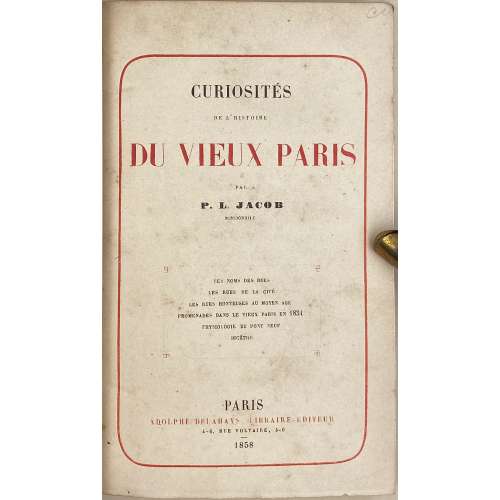 Title-page: CURIOSITÉS | DE L’HISTOIRE | DU VIEUX PARIS | PAR | P. L. JACOB | BIBLIOPHILE | { LES NOMS DES RUES | LES RUES DE CITÉ | LES RUES HONTEUSES AU MOYEN AGE. | PROMENADES DANS LE VIEUX PARIS EN 1834. | PHYSIOLOGIE DU PONT NEUF. | BICÊTRE } | PARIS | ADOLPHE DELAHAYS, LIBRAIRE-ÉDITEUR | 4-6, RUE VOLTAIRE, 4-6 | – | 1858 || Description: Hardcover, in-16o, 17 x 11 cm, quarter brown morocco over marbled boards, spine with raised bands, gilt lettering, gilt fleurons, marbled endpapers, original wrappers with red and black lettering within red frame bound in, some pages uncut. Collation: 8vo; π2 14, 2-238 244, total 186 leaves between original wrappers. Pagination: [4] [1] 2-364 [4], total 372 pages. Catalogue raisonné: Vicar: I, 770. Contributors: Printer: Simon Raçon et Comp. (Paris). Author: Paul Lacroix [P. L. Jacob] (French, 1806 – 1884). Publisher: Adolphe Delahays (French, mid-19th century).
Title-page: CURIOSITÉS | DE L’HISTOIRE | DU VIEUX PARIS | PAR | P. L. JACOB | BIBLIOPHILE | { LES NOMS DES RUES | LES RUES DE CITÉ | LES RUES HONTEUSES AU MOYEN AGE. | PROMENADES DANS LE VIEUX PARIS EN 1834. | PHYSIOLOGIE DU PONT NEUF. | BICÊTRE } | PARIS | ADOLPHE DELAHAYS, LIBRAIRE-ÉDITEUR | 4-6, RUE VOLTAIRE, 4-6 | – | 1858 || Description: Hardcover, in-16o, 17 x 11 cm, quarter brown morocco over marbled boards, spine with raised bands, gilt lettering, gilt fleurons, marbled endpapers, original wrappers with red and black lettering within red frame bound in, some pages uncut. Collation: 8vo; π2 14, 2-238 244, total 186 leaves between original wrappers. Pagination: [4] [1] 2-364 [4], total 372 pages. Catalogue raisonné: Vicar: I, 770. Contributors: Printer: Simon Raçon et Comp. (Paris). Author: Paul Lacroix [P. L. Jacob] (French, 1806 – 1884). Publisher: Adolphe Delahays (French, mid-19th century). -
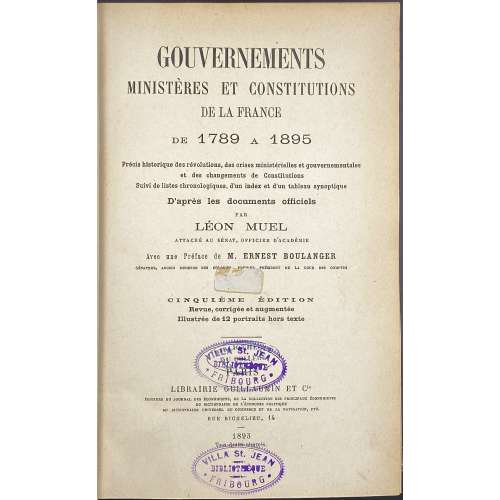 Title-page: GOUVERNEMENTS | MINISTÈRES ET CONSTITUTIONS | DE LA FRANCE | DE 1789 A 1895 | Précis historique des révolutions, des crises ministérielles et gouvernementales | et des changements de Constitutions | Suivi de listes chronologiques, d’un index et d’un tableau synoptique | D’après les documents officiels | PAR | LÉON MUEL | ATTACHÉ AU SÉNAT, OFFICIER D’ACADÉMIE | Avec une Préface de M. ERNEST BOULANGER | SÉNATEUR, ANCIEN MINISTRE DES COLONIES, PREMIER PRÉSIDENT DE LA COUR DES COMPTES | CINQUIÈME ÉDITION | Revue, corrigée et augmentée | Illustrée de 12 portraits hors texte | — | PARIS | LIBRAIRIE GUILLAUMIN ET Cie | ÉDITEURS DU JOURNAL DES ÉCONOMISTES, DE LA COLLECTION DES PRINCIPAUX ÉCONOMISTES | DU DICTIONNAIRE DE L’ÉCONOMIE POLITIQUE | DU DICTIONNAIRE UNIVERSEL DU COMMERCE ET DE LA NAVIGATION, ETC. | RUE RICHELIEU, 14 | 1895 | Tous droits réservés. || Binding: Hardcover, 22.1 x 16.6 cm x 5.0 cm, 8vo, quarter brown morocco over marbled boards, raised bands with gilt fillets and black label with gilt lettering to spine, marbled endpapers. Library stamps to t.p. and inside in blue ink: “VILLA St. JEAN | BIBLIOTHÈQUE | * FRIBOURG *”. Villa St. Jean International School, originally named Collège Villa St. Jean, was a private Catholic school in Fribourg, Switzerland, from 1903 to 1970 (see Wikipedia). Collation: ffl, π4, [1] 2-348, χ6, Suppl.: [1] 2-98, χ2, ffl; total within the flyleaves 282+76 leaves, some uncut; plus twelve plates (photographs) with tissue guards and two folding tables. Pagination: [i-v] vi-x, [2] [1] 2-4, (lacks 4: 5-8) [9] 10-535 [536] (lacks 2: 537, 538) [539] 540-557 [558 blank]; Supplément [1] 2-144, [145-6 table alphabét./blank], [147-8 table des matières/blank]; total within the flyleaves 564+148 pages, ils., plates. Provenance: Library of Villa St. Jean, Fribourg, Switzerland. Contributors: Muel, Léon (French, 1850 – 19..?) – author. Boulanger, Ernest-Théophile (French, 1831 – 1907) – author of preface. Librairie de Guillaumin et Cie – publisher. Table of contents:AVANT-PROPOSLETTRE-PRÉFACEPREMIÈRE PARTIEI. – MONARCHIE FRANÇAISE – BOURBONSLouis XVI, roi de France et de Navarre (10 MAI 1774 – 21 SEPTEMBRE 1792)II. – RÉPUBLIQUE FRANÇAISE (21 SEPTEMBRE 1792 – 18 MAI 1804)Convention nationale (20 SEPTEMBRE 1792 – 26 OCTOBRE 1795)Directoire exécutif (2 NOVEMBRE 1795 – 10 NOVEMBRE 1799)Consulat (19 BRUMAIRE AN VIII – 28 FLORÉAL AN XII) (10 NOVEMBRE 1799-18 MAI 1804);III. – EMPIRE FRANÇAIS (18 MAI 1804 – 31 MARS 1814)Napoléon Ier, Empereur des Français (18 MAI 1804 – 31 MARS 1814)Gouvernement provisoire (1er 14 AVRIL 1814)IV. – RESTAURATION – BOURBONS (14 AVRIL 1814 – 29 JUILLET 1830)Lieutenance générale du Royaume (14 AVRIL – 2 MAI 1814)Louis XVIII, roi de France et de Navarre (2 MAI 1814 – 20 MARS 1815)Cent Jours (20 MARS – 22 JUIN 1815)Commission de Gouvernement (22 JUIN – 7 JUILLET 1815)Louis XVIII, roi de France et de Navarre (8 JUILLET 1815 – 16 SEPTEMBRE 1824)Charles X, roi de France et de Navarre (16 SEPTEMBRE 1824 – 29 JUILLET 1830)Révolution de 1830Chute de Charles X et du ministère Polignac (29 JUILLET 1830). Gouvernement provisoire (29 – 31 JUILLET 1830)V. – MONARCHIE CONSTITUTIONNELLE – BRANCHE D'ORLÉANS (31 JUILLET 1830 – 24 FÉVRIER 1848)Lieutenance générale du Royaume (31 JUILLET – 9 AOUT 1830)Louis-Philippe Ier, roi des Français (9 AOUT 1830 – 24 FÉVRIER 1848)Révolution de 1848Chute du ministère Guizot (23 février) et du roi Louis-Philippe (24 février 1848)VI. – DEUXIÈME RÉPUBLIQUE FRANÇAISE (24 FÉVRIER 1848 – 2 DÉCEMBRE 1852)Gouvernement provisoire (24 FÉVRIER – 9 MAI 1848)Assemblée Nationale Constituante (4 MAI 1848 – 26 MAI 1849)Commission exécutive (9 MAI – 24 JUIN 1848)Le général Cavaignac chef du Pouvoir exécutif Président du Conseil des Ministres (28 JUIN – 20 DÉCEMBRE 1848)Louis-Napoléon Bonaparte Président de la République Française (20 DÉCEMBRE 1848 – 2 DÉCEMBRE 1852)VII. – SECOND EMPIRE FRANÇAIS (2 DÉCEMBRE 1852 – 4 SEPTEMBRE 1870)Napoléon III, empereur des Français (2 DÉCEMBRE 1852 – 4 SEPTEMBRE 1870)Révolution du 4 septembre 1870 Chute du second Empire et du ministère PalikaoVIII. – TROISIÈME RÉPUBLIQUE FRANÇAISE (4 SEPTEMBRE 1870)Gouvernement de la Défense nationale (4 SEPTEMBRE 1870 – 17 FÉVRIER 1871)Assemblée Nationale Constituante (13 FÉVRIER 1871 – 8 MARS 1876)M. Thiers Chef du Pouvoir exécutif (17 FÉVRIER – 31 AOUT 1871)M. Thiers Président de la République Française (31 AOUT 1871 – 24 MAI 1873)M. le Maréchal de Mac-Mahon, duc de Magenta Président de la République Française (24 MAI 1873 – 30 JANVIER 1879)M. Jules Grévy Président de la République Française (30 JANVIER 1879 – 2 DÉCEMBRE 1887)M. Carnot Président de la République française (3 DÉCEMBRE 1887 – 25 JUIN 1894)SECONDE PARTIE.Listes chronologiques, par ministère, de tous les ministres, depuis le 5 mai 1789 jusqu'en 1890
Title-page: GOUVERNEMENTS | MINISTÈRES ET CONSTITUTIONS | DE LA FRANCE | DE 1789 A 1895 | Précis historique des révolutions, des crises ministérielles et gouvernementales | et des changements de Constitutions | Suivi de listes chronologiques, d’un index et d’un tableau synoptique | D’après les documents officiels | PAR | LÉON MUEL | ATTACHÉ AU SÉNAT, OFFICIER D’ACADÉMIE | Avec une Préface de M. ERNEST BOULANGER | SÉNATEUR, ANCIEN MINISTRE DES COLONIES, PREMIER PRÉSIDENT DE LA COUR DES COMPTES | CINQUIÈME ÉDITION | Revue, corrigée et augmentée | Illustrée de 12 portraits hors texte | — | PARIS | LIBRAIRIE GUILLAUMIN ET Cie | ÉDITEURS DU JOURNAL DES ÉCONOMISTES, DE LA COLLECTION DES PRINCIPAUX ÉCONOMISTES | DU DICTIONNAIRE DE L’ÉCONOMIE POLITIQUE | DU DICTIONNAIRE UNIVERSEL DU COMMERCE ET DE LA NAVIGATION, ETC. | RUE RICHELIEU, 14 | 1895 | Tous droits réservés. || Binding: Hardcover, 22.1 x 16.6 cm x 5.0 cm, 8vo, quarter brown morocco over marbled boards, raised bands with gilt fillets and black label with gilt lettering to spine, marbled endpapers. Library stamps to t.p. and inside in blue ink: “VILLA St. JEAN | BIBLIOTHÈQUE | * FRIBOURG *”. Villa St. Jean International School, originally named Collège Villa St. Jean, was a private Catholic school in Fribourg, Switzerland, from 1903 to 1970 (see Wikipedia). Collation: ffl, π4, [1] 2-348, χ6, Suppl.: [1] 2-98, χ2, ffl; total within the flyleaves 282+76 leaves, some uncut; plus twelve plates (photographs) with tissue guards and two folding tables. Pagination: [i-v] vi-x, [2] [1] 2-4, (lacks 4: 5-8) [9] 10-535 [536] (lacks 2: 537, 538) [539] 540-557 [558 blank]; Supplément [1] 2-144, [145-6 table alphabét./blank], [147-8 table des matières/blank]; total within the flyleaves 564+148 pages, ils., plates. Provenance: Library of Villa St. Jean, Fribourg, Switzerland. Contributors: Muel, Léon (French, 1850 – 19..?) – author. Boulanger, Ernest-Théophile (French, 1831 – 1907) – author of preface. Librairie de Guillaumin et Cie – publisher. Table of contents:AVANT-PROPOSLETTRE-PRÉFACEPREMIÈRE PARTIEI. – MONARCHIE FRANÇAISE – BOURBONSLouis XVI, roi de France et de Navarre (10 MAI 1774 – 21 SEPTEMBRE 1792)II. – RÉPUBLIQUE FRANÇAISE (21 SEPTEMBRE 1792 – 18 MAI 1804)Convention nationale (20 SEPTEMBRE 1792 – 26 OCTOBRE 1795)Directoire exécutif (2 NOVEMBRE 1795 – 10 NOVEMBRE 1799)Consulat (19 BRUMAIRE AN VIII – 28 FLORÉAL AN XII) (10 NOVEMBRE 1799-18 MAI 1804);III. – EMPIRE FRANÇAIS (18 MAI 1804 – 31 MARS 1814)Napoléon Ier, Empereur des Français (18 MAI 1804 – 31 MARS 1814)Gouvernement provisoire (1er 14 AVRIL 1814)IV. – RESTAURATION – BOURBONS (14 AVRIL 1814 – 29 JUILLET 1830)Lieutenance générale du Royaume (14 AVRIL – 2 MAI 1814)Louis XVIII, roi de France et de Navarre (2 MAI 1814 – 20 MARS 1815)Cent Jours (20 MARS – 22 JUIN 1815)Commission de Gouvernement (22 JUIN – 7 JUILLET 1815)Louis XVIII, roi de France et de Navarre (8 JUILLET 1815 – 16 SEPTEMBRE 1824)Charles X, roi de France et de Navarre (16 SEPTEMBRE 1824 – 29 JUILLET 1830)Révolution de 1830Chute de Charles X et du ministère Polignac (29 JUILLET 1830). Gouvernement provisoire (29 – 31 JUILLET 1830)V. – MONARCHIE CONSTITUTIONNELLE – BRANCHE D'ORLÉANS (31 JUILLET 1830 – 24 FÉVRIER 1848)Lieutenance générale du Royaume (31 JUILLET – 9 AOUT 1830)Louis-Philippe Ier, roi des Français (9 AOUT 1830 – 24 FÉVRIER 1848)Révolution de 1848Chute du ministère Guizot (23 février) et du roi Louis-Philippe (24 février 1848)VI. – DEUXIÈME RÉPUBLIQUE FRANÇAISE (24 FÉVRIER 1848 – 2 DÉCEMBRE 1852)Gouvernement provisoire (24 FÉVRIER – 9 MAI 1848)Assemblée Nationale Constituante (4 MAI 1848 – 26 MAI 1849)Commission exécutive (9 MAI – 24 JUIN 1848)Le général Cavaignac chef du Pouvoir exécutif Président du Conseil des Ministres (28 JUIN – 20 DÉCEMBRE 1848)Louis-Napoléon Bonaparte Président de la République Française (20 DÉCEMBRE 1848 – 2 DÉCEMBRE 1852)VII. – SECOND EMPIRE FRANÇAIS (2 DÉCEMBRE 1852 – 4 SEPTEMBRE 1870)Napoléon III, empereur des Français (2 DÉCEMBRE 1852 – 4 SEPTEMBRE 1870)Révolution du 4 septembre 1870 Chute du second Empire et du ministère PalikaoVIII. – TROISIÈME RÉPUBLIQUE FRANÇAISE (4 SEPTEMBRE 1870)Gouvernement de la Défense nationale (4 SEPTEMBRE 1870 – 17 FÉVRIER 1871)Assemblée Nationale Constituante (13 FÉVRIER 1871 – 8 MARS 1876)M. Thiers Chef du Pouvoir exécutif (17 FÉVRIER – 31 AOUT 1871)M. Thiers Président de la République Française (31 AOUT 1871 – 24 MAI 1873)M. le Maréchal de Mac-Mahon, duc de Magenta Président de la République Française (24 MAI 1873 – 30 JANVIER 1879)M. Jules Grévy Président de la République Française (30 JANVIER 1879 – 2 DÉCEMBRE 1887)M. Carnot Président de la République française (3 DÉCEMBRE 1887 – 25 JUIN 1894)SECONDE PARTIE.Listes chronologiques, par ministère, de tous les ministres, depuis le 5 mai 1789 jusqu'en 1890 -
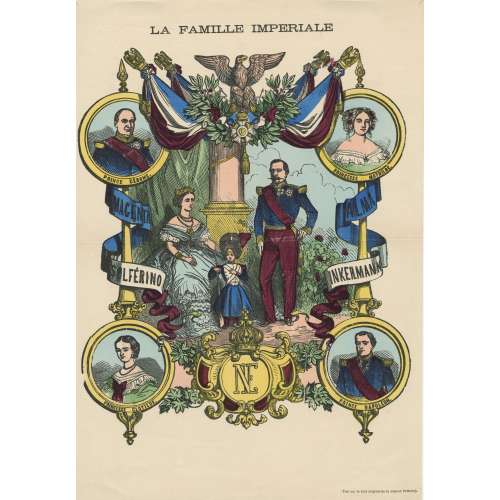 Hand-coloured woodcut on laid paper, 422 x 294 mm; black ink stamp “5307” to reverse, centrefold. Top center: "LA FAMILLE IMPERIALE"; Bottom right: "(Tire sur le bois original de maison Pellerin)". Image: Napoléon III, Empress Eugenie, and Prince Imperial Louis-Napoléon as a child surrounded with four lettered medallions: “PRINCE GÉROME”, “PRINCESSE MATHILDE”, “PRINCESSE CLOTILDE”, and “PRINCE NAPOLÉON”; ribbons lettered: “MAGENTA”, SOLFERINO”, “ALMA”, and “INKERMANN” around heraldic spears; coat of arms with imperial monogram between Princesse Clotilde and Prince Napoléon. Publisher/printer: Jean Charles Pellerin (French, 1756 – 1836). Battle of Magenta : 4 June 1859, against the Austrians. Battle of Solferino : 24 June 1859, against the Austrians. Battle of the Alma : 20 September 1854 (Crimean War) Battle of Inkerman : 5 November 1854 (Crimean War) Characters: Napoleon III [Charles-Louis Napoléon Bonaparte] (French, 1808 – 1873) Eugénie de Montijo [L'impératrice Eugénie] (Spanish-French, 1826 – 1920) Napoléon, Prince Imperial (Napoléon Eugène Louis Jean Joseph Bonaparte] (French, 1856 – 1879) Napoléon-Jérôme Bonaparte [Prince Jérôme] (French, 1822 – 1891) Mathilde Bonaparte [Princess Mathilde] (French, 1820 – 1904) Marie-Clotilde de Savoie [Princesse Clotilde] (French, 1843 – 1911)
Hand-coloured woodcut on laid paper, 422 x 294 mm; black ink stamp “5307” to reverse, centrefold. Top center: "LA FAMILLE IMPERIALE"; Bottom right: "(Tire sur le bois original de maison Pellerin)". Image: Napoléon III, Empress Eugenie, and Prince Imperial Louis-Napoléon as a child surrounded with four lettered medallions: “PRINCE GÉROME”, “PRINCESSE MATHILDE”, “PRINCESSE CLOTILDE”, and “PRINCE NAPOLÉON”; ribbons lettered: “MAGENTA”, SOLFERINO”, “ALMA”, and “INKERMANN” around heraldic spears; coat of arms with imperial monogram between Princesse Clotilde and Prince Napoléon. Publisher/printer: Jean Charles Pellerin (French, 1756 – 1836). Battle of Magenta : 4 June 1859, against the Austrians. Battle of Solferino : 24 June 1859, against the Austrians. Battle of the Alma : 20 September 1854 (Crimean War) Battle of Inkerman : 5 November 1854 (Crimean War) Characters: Napoleon III [Charles-Louis Napoléon Bonaparte] (French, 1808 – 1873) Eugénie de Montijo [L'impératrice Eugénie] (Spanish-French, 1826 – 1920) Napoléon, Prince Imperial (Napoléon Eugène Louis Jean Joseph Bonaparte] (French, 1856 – 1879) Napoléon-Jérôme Bonaparte [Prince Jérôme] (French, 1822 – 1891) Mathilde Bonaparte [Princess Mathilde] (French, 1820 – 1904) Marie-Clotilde de Savoie [Princesse Clotilde] (French, 1843 – 1911) -
 Bando Mitsugoro II as Soga no Taro Sukenobu, the step-father of the Soga brothers, and Osagawa Tsuneyo II as Onio's wife Tsukisayo, in the play 'Omonbi Kuruwa Soga' performed at the Ichimura-za in the 1st month of 1799. Reference: Harvard Art Museums accession number 1933.4.525. Publications: Narazaki Muneshige, Ukiyo-e shuka [Collection of the Masterpieces of Ukiyo-e Prints in Museums] Volume 8: Foggu Bijutsukan [Fogg Art Museum, Harvard University], Neruson Bijutsukan [Nelson Atkins Museum]..., Shogaku-kan (Tokyo, Japan, 1980 [Showa 55]), Color Plate 107; p. 104 (entry p. 191). SOLD
Bando Mitsugoro II as Soga no Taro Sukenobu, the step-father of the Soga brothers, and Osagawa Tsuneyo II as Onio's wife Tsukisayo, in the play 'Omonbi Kuruwa Soga' performed at the Ichimura-za in the 1st month of 1799. Reference: Harvard Art Museums accession number 1933.4.525. Publications: Narazaki Muneshige, Ukiyo-e shuka [Collection of the Masterpieces of Ukiyo-e Prints in Museums] Volume 8: Foggu Bijutsukan [Fogg Art Museum, Harvard University], Neruson Bijutsukan [Nelson Atkins Museum]..., Shogaku-kan (Tokyo, Japan, 1980 [Showa 55]), Color Plate 107; p. 104 (entry p. 191). SOLD -
 Shakudō tsuba of the slightly vertically elongated round form (nagamaru-gata) decorated by gold in flat inlay (hira-zōgan) with three insects (cricket, locust, and praying mantis), grass and dewdrops motif. Kogai hitsu-ana is plugged with gilded soft metal. Height: 70.2 mm; width: 66.4 mm x Thickness at seppa-dai: 4.5 mm. Edo period (from ca. 1700 to ca. 1850) Unsigned. Attributed to Kaga School or Murakami School. Almost identical tsuba (no dewdrops, though) is illustrated and described at page 60 of Kokusai Tosogu Kai. 7th International Convention & Exhibition, November 1st, 2011 at Tokyo National Museum, page 60. It is attributed to the Kaga School, Mid Edo period (Late 17th - early 18th century). Dimensions: 70.5 x 66 x 4.5 mm. "The rich black shakudo plate has been slightly lowered (dished out) and then polished. Gold insects crawl amongst grasses, depicted by Kaga style hirazogan (flat inlay). One tendril of the mantis overlaps onto seppa-dai. The mantis boldly looks out from the tsuba in a curious way. This style of Kaga tsuba was popular during the Genroku era (1688-1703)."Another source is Japanese Sword Fittings. A descriptive catalogue of the Collection of G.H. Naunton, Esq., completed and illustrated by Henri L. Joly, - 1912:
Shakudō tsuba of the slightly vertically elongated round form (nagamaru-gata) decorated by gold in flat inlay (hira-zōgan) with three insects (cricket, locust, and praying mantis), grass and dewdrops motif. Kogai hitsu-ana is plugged with gilded soft metal. Height: 70.2 mm; width: 66.4 mm x Thickness at seppa-dai: 4.5 mm. Edo period (from ca. 1700 to ca. 1850) Unsigned. Attributed to Kaga School or Murakami School. Almost identical tsuba (no dewdrops, though) is illustrated and described at page 60 of Kokusai Tosogu Kai. 7th International Convention & Exhibition, November 1st, 2011 at Tokyo National Museum, page 60. It is attributed to the Kaga School, Mid Edo period (Late 17th - early 18th century). Dimensions: 70.5 x 66 x 4.5 mm. "The rich black shakudo plate has been slightly lowered (dished out) and then polished. Gold insects crawl amongst grasses, depicted by Kaga style hirazogan (flat inlay). One tendril of the mantis overlaps onto seppa-dai. The mantis boldly looks out from the tsuba in a curious way. This style of Kaga tsuba was popular during the Genroku era (1688-1703)."Another source is Japanese Sword Fittings. A descriptive catalogue of the Collection of G.H. Naunton, Esq., completed and illustrated by Henri L. Joly, - 1912:
7-U17. Ron Hartmann Collection.
Kanazawa in Kaga was a centre of fine metal work during the whole of the Tokugawa period. At first the inlayers of Fushimi following the Daimyo Maeda went to Kanazawa, then some of the Gotō masters proceeded from Kyoto for short periods to work for the Daimyo, so that their influence was strongly impressed upon Kaga work..." A somewhat look-a-like tsuba is illustrated at plate XXVIII, Kaga Inlay, №653 with the following description at page 52: "Shakudō, inlaid with five insects in gold: crickets, praying mantis, grasshopper, in the style of Takagawara Ujitsugu.
According to M. Sesko, Ujitsugu was a master from Katsuki and Kaneko School in Kaga, son of Ujihira. Ujihira's father Ujiyoshi died in 1802. This brings us to the mid-19th century, instead of mid-18th or earlier. On the other hand, a very much look alike specimen at MFA collection (ACCESSION NUMBER 17.1061) has the with the following description: Edo period. Late 18th–early 19th century. Murakami School. Main material: shakudo; other metals: gold; decorative technique: iroe hirazogan.A detailed account of Murakami school can be found at The Japanese toso-kinko Schools.// Lulu Inc., 2012 by Markus Sesko, on pages 235-239. All-in-all, it's either Kaga School or Murakami School, either ca. 1700 or ca. 1850. Quite a range! SOLD
MFA # 17.1061
-
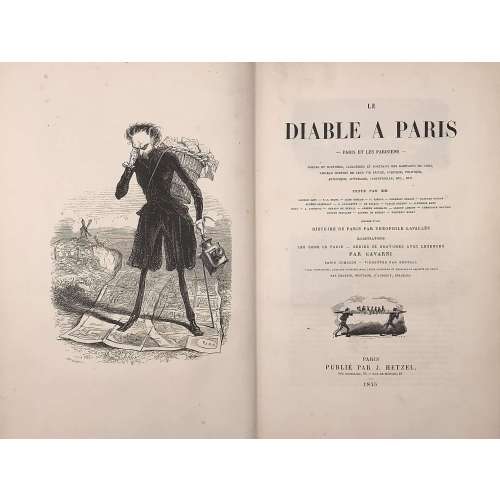
A two-volume set, published in Paris by P.-J. Hetzel in 1845 and 1846.
Vol. 1:
Title: LE | DIABLE A PARIS | — PARIS ET LES PARISIENS — | MŒURS ET COUTUMES, CARACTERES ET PORTRAITS DES HABITANTS DE PARIS, | TABLEAU COMPLET DE LEUR VIE PRIVEE, PUBLIQUE, POLITIQUE, | ARTISTIQUE, LITTERAIRE, INDUSTRIELLE, ETC., ETC. | TEXTE PAR MM. | GEORGE SAND — P.-J. STAHL — LEON GOZLAN — P. PASCAL — FREDERIC SOULIE — CHARLES NODIER | EUGENE BRIFFAULT — S. LAVALETTE — DE BALZAC — TAXILE DELORD — ALPHONSE KARR | MÉRY — A. JUNCETIS — GERARD DE NERVAL — ARSÈNE HOUSSAYE — ALBERT AUBERT — THÉOPHILE GAUTIER | OCTAVE FEUILLET — ALFRED DE MUSSET — FRÉDÉRIC BÉRAT | précédé d’une | HISTOIRE DE PARIS PAR THEOPHILE LAVALLÉE | ILLUSTRATIONS | LES GENS DE PARIS — SERIES DE GRAVURES AVEC LEGENDES | PAR GAVARNI | PARIS COMIQUE — VIGNETTES DE BERTALL | VUES, MONUMENTS, EDIFICES PARTICULIERS, LIEUX CÉLÈBRES ET PRINCIPAUX ASPECTS DE PARIS | PAR CHAMPIN, BERTRAND, D’AUBIGNY, FRANÇAIS. | [DEVICE] | PARIS | PUBLIÉ PAR J. HETZEL, | RUE RICHELIEU, 76 – RUE DE MÉNARS, 10. | 1845 ||
Pagination: ffl, [2 – h.t. / Paris: Typographie Lacrampe et Comp., Rue Damiette, 2 ; Papeir de la fabrique de sainte-marie] [2 – blank / frontis. ‘Diable’ with lantern standing on map of Paris] [2 – t.p. /blank] [I] II-XXXII, [1] 2-380, bfl. Sheet size: 27.5 x 17.5 cm.
Collation: 4to; A(4) – D(4), [1(4)] 2(4) – 47(4), 48(2); illustrations: frontispiece, vignette title-page, numerous text engravings and 99 plates.
Vol. 2: Title: LE | DIABLE A PARIS | — PARIS ET LES PARISIENS — | MŒURS ET COUTUMES, CARACTERES ET PORTRAITS DES HABITANTS DE PARIS, | TABLEAU COMPLET DE LEUR VIE PRIVEE, PUBLIQUE, POLITIQUE, | ARTISTIQUE, LITTERAIRE, INDUSTRIELLE, ETC., ETC. | TEXTE PAR MM. | DE BALZAC — EUGÈNE SUE — GEORGE SAND — P.-J. STAHL — ALPHONSE KARR | HENRY MONNIER — OCTAVE FEUILLET — DE STENDAHL — LEON GOZLAN — S. LAVALETTE — ARMAND MARRAST | LAURENT-JAN —ÉDOUARD OURLIAC — CHARLES DE BOIGNE — ALTAROCHE — EUG. GUINOT | JULES JANIN — EUGENE BRIFFAULT — AUGUSTE BARBIER — MERQUIS DE VARENNES — ALFRED DE MUSSET | CHARLES NODIER — FRÉDÉRIC BÉRAT — A. LEGOYT| précédé d’une | GÉOGRAPHIE DE PARIS PAR THEOPHILE LAVALLÉE | ILLUSTRATIONS | LES GENS DE PARIS — SERIES DE GRAVURES AVEC LEGENDES | PAR GAVARNI | PARIS COMIQUE — PANTHÉON DU DIABLE A PARIS PAR BERTALL | VUES, MONUMENTS, EDIFICES PARTICULIERS, LIEUX CÉLÈBRES ET PRINCIPAUX ASPECTS DE PARIS | PAR CHAMPIN, BERTRAND, D’AUBIGNY, FRANÇAIS. | [DEVICE] | PARIS | PUBLIÉ PAR J. HETZEL, | RUE RICHELIEU, 76 – RUE DE MÉNARS, 10. | 1846 || Pp. : ffl, [2 – h.t. / Paris: Typographie Lacrampe et Comp., Rue Damiette, 2 ; Papeir de la fabrique de sainte-marie] [2 – t.p. /blank] [I] II-LXXX, [1] 2-364, bfl. Sheet size: 27.5 x 17.5 cm. Collation: 4to; A(4) – I(4) – J(4), 1(4), 2(4) – 45(4), 46(2); illustrations: vignette title-page, numerous text engravings and 112 plates.Binding: [allegedly Roger de Coverly (British, 1831 — 1914)], 28.2 x 19 cm, ¾ brown calf ruled in gilt, brown marbled boards, nonpareil marbled endpapers, raised and ruled in gilt bands, floral devices and title lettering to spine. AEG. Foxing to flyleaves, tips of corners just a very little rubbed as are the glazed marbled paper boards; endpapers foxed; very occasional light scattered foxing of text.
Provenance: (1) Armorial bookplate (Ex Libris Sir John Whittaker Ellis, 1st Baronet (1829 – 1912), Lord Mayor of London 1881; (2) Bookplate Ex Libris Robert Frederick Green) dated 1909.
Reference: L. Carteret (1927) pp. 203-207: the first edition, lacking the publisher's white pictorial wrappers. -
 Artist: Utagawa Sadahide [歌川 貞秀], a.k.a. Gountei Sadahide [五雲亭 貞秀] (1807 – c. 1878/9). Signed: Gountei Sadahide ga [五雲亭貞秀画] Pubisher: Ibaya Senzaburō [伊場屋仙三郎] (Japanese, 1815 – 1869) Date-aratame seal: Bunsei 13 / Tenpō 1 (1830). Ref: Ritsumeikan University # Z0172-587. Title: Yukari no Edo-zakura [ゆかりの江戸桜], often translated into English as 'The Flower of Edo', is a one-act kabuki play Sukeroku, written by Tsuuchi Han'emon (fl. 1701 – 1743) under the supervision of Tsuuchi Jihei II (1673 – 1760 ) at the beginning of the 18th century. From the beginning of the 19th century, the play was performed in the style of katōbushi. 助六所縁江戸桜(すけろくゆかりのえどざくら。「助六」– one of the main melodies in katōbushi (河東節) type of jōruri [浄瑠璃]. For a detailed explanation in Japanese, see also HERE). Plot: In search of the stolen Minamoto clan's precious sword called Tomokirimaru, Soga Gorō (historical Soga Tokimune [曾我時致], 1174 – 1193) came to a Yoshiwara brothel under the disguise of a debaucher named Hanagawado Sukeroku. His elder brother, Soga Jūrō (historical Soga Sukenari [曾我祐成], 1172 – 1193) ), has assumed the guise of a wine vendor Shinbei. The character who had the Tomokirimaru sword was Ikyū (historical Iga no Heinaizaemon, a Tiara clan's ally), see SVJP-0164.2014. A series of three prints is dedicated to a katōbushi performance of the Soga-themed plays.
Artist: Utagawa Sadahide [歌川 貞秀], a.k.a. Gountei Sadahide [五雲亭 貞秀] (1807 – c. 1878/9). Signed: Gountei Sadahide ga [五雲亭貞秀画] Pubisher: Ibaya Senzaburō [伊場屋仙三郎] (Japanese, 1815 – 1869) Date-aratame seal: Bunsei 13 / Tenpō 1 (1830). Ref: Ritsumeikan University # Z0172-587. Title: Yukari no Edo-zakura [ゆかりの江戸桜], often translated into English as 'The Flower of Edo', is a one-act kabuki play Sukeroku, written by Tsuuchi Han'emon (fl. 1701 – 1743) under the supervision of Tsuuchi Jihei II (1673 – 1760 ) at the beginning of the 18th century. From the beginning of the 19th century, the play was performed in the style of katōbushi. 助六所縁江戸桜(すけろくゆかりのえどざくら。「助六」– one of the main melodies in katōbushi (河東節) type of jōruri [浄瑠璃]. For a detailed explanation in Japanese, see also HERE). Plot: In search of the stolen Minamoto clan's precious sword called Tomokirimaru, Soga Gorō (historical Soga Tokimune [曾我時致], 1174 – 1193) came to a Yoshiwara brothel under the disguise of a debaucher named Hanagawado Sukeroku. His elder brother, Soga Jūrō (historical Soga Sukenari [曾我祐成], 1172 – 1193) ), has assumed the guise of a wine vendor Shinbei. The character who had the Tomokirimaru sword was Ikyū (historical Iga no Heinaizaemon, a Tiara clan's ally), see SVJP-0164.2014. A series of three prints is dedicated to a katōbushi performance of the Soga-themed plays.
They all have a background of hail patterns (Arare-ko-mon) [霰小紋], similar to Kunisada’s Iwai Kumesaburō II as An no Heibei [SVJP-0304.2019], see below.Yukari no Edo-zakura The tatami night robe of Iwao Tangled Hair and the Evening Braided Hat 
-
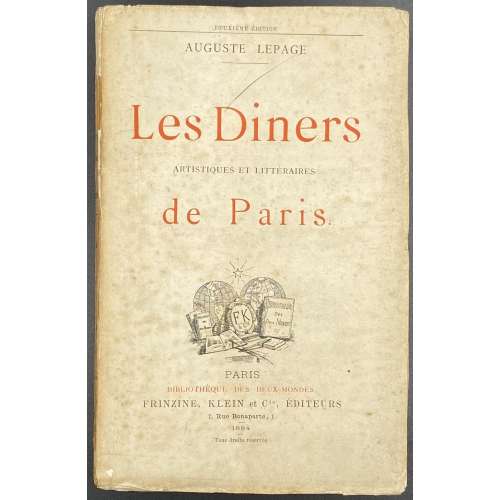 Cover: Publisher's wrappers, to front cover with black and red lettering: DEUXIÈME ÉDITION |—| AUGUSTE LEPAGE | Les Diners | ARTISTIQUES ET LITTÉRAIRES | de Paris | {publisher's device} | PARIS | BIBLIOTHÈQUE DES DEAUX MONDES| FRINZINE, KLEIN et Cie, ÉDIREURS | 1, RUE BONAPARTE, 1 | 1884 | Tous droits réservés || Title page: Similar lettering t.p. in black only, with "DEUXIÈME ÉDITION" below "de Paris". Pagination: front wrapper with a pasted leaf, [iii-vii] viii-xi [xii] [1-3] 4-360, back wrapper with a pasted 3/4 leaf, black lattering to spine. Collation: 18mo; π5, 1-1918-206.
Cover: Publisher's wrappers, to front cover with black and red lettering: DEUXIÈME ÉDITION |—| AUGUSTE LEPAGE | Les Diners | ARTISTIQUES ET LITTÉRAIRES | de Paris | {publisher's device} | PARIS | BIBLIOTHÈQUE DES DEAUX MONDES| FRINZINE, KLEIN et Cie, ÉDIREURS | 1, RUE BONAPARTE, 1 | 1884 | Tous droits réservés || Title page: Similar lettering t.p. in black only, with "DEUXIÈME ÉDITION" below "de Paris". Pagination: front wrapper with a pasted leaf, [iii-vii] viii-xi [xii] [1-3] 4-360, back wrapper with a pasted 3/4 leaf, black lattering to spine. Collation: 18mo; π5, 1-1918-206. -
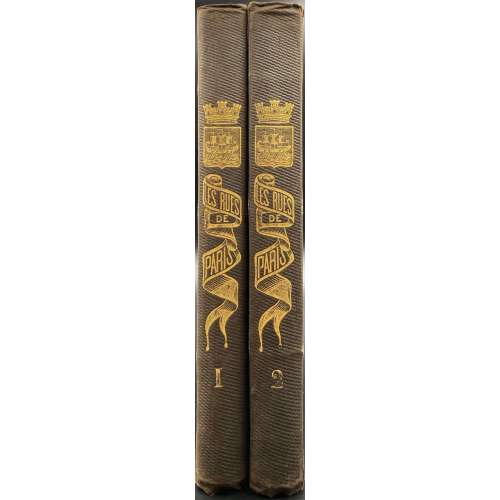 Vol. 1 : Title : LES | RUES DE PARIS | PARIS ANCIEN ET MODERNE | ORIGINES, HISTOIRE | MONUMENTS, COSTUMES, MŒURS, CHRONIQUES ET TRADITIONS | OUVRAGE | RÉDIGÉ PAR L’ÉLITE DE LA LITTÉRATURE CONTEMPORAINE | SOUS LA DIRECTION DE | LOUIS LURINE | et illustré de 300 dessins exécutés par les artistes les plus distingués | TOME PREMIER | { publisher’s device «G.K.» in vignette} | PARIS | G. KUGELMANN, ÉDITEUR, 25 RUE JACOB | 1844 || Pagination: [4] [1] 2-396 [4], total number of pages 404, plus 21 wood-engraved plates, incl. frontispiece, extraneous to collation. Collation: 4to; π2 [1]4 2-504, total number of leaves 202, plus 21 leaves of plates. Vol. 2: Title: Same, “TOME SECOND”. Pagination: [4] [1] 2-411 [412] [4], total number of pages 420, plus 22 wood engraved plates, incl. frontispiece, extraneous to collation. Collation: 4to; π2, 1-524, total number of leaves 210, plus 22 leaves of plates. Binding: 27 x 17 cm, two volumes uniformly bound by the publisher in brown cloth, blind-stamped frame and gilt design (corners, coat of arms of Paris, lettering) to boards and spine, yellow endpapers. CONTRIBUTORS: Printer: Alfred Wittersheim (French, 1825 – 1881) Publisher: Georges Kugelmann (French, 1809 – 1882) Editor/Compiler: Louis Lurine (French, 1816 – 1860) Texts by: Briffault, Eugène (French, 1799 – 1854); Janin, Jules Gabriel (French, 1804 – 1874); Huart, Louis Adrien (French, 1813 – 1865); Burette, Théodose (French, 1804 – 1847); Beauvoir, Roger de (French, 1806 – 1866); Brot, Charles Alphonse (French, 1807 – 1895); Le Roux de Lincy, Antoine (French, 1806 – 1869); Achard, Louis Amédée Eugène (French, 1814 – 1875). Illustrated book, profusely illustrated with over 300 woodcuts by: Artists: Daumier, Honoré (French, 1808 – 1879); Gavarni , Paul [Chevalier, Hippolyte Guillaume Sulpice] (French, 1804 – 1866); Nanteuil, Célestin François (French, 1813 – 1873); Baron, Henri (French, 1816 – 1885); Beaumont, Édouard de (French, 1821 – 1888); David, Jules (French, 1808 – 1892); Marckl, Louis (French, b. 1807); Schlesinger, Heinrich [Henri-Guillaume] (German-French, 1814 – 1893); Collignon, François Jules (French, d. 1850); Godefroy, Félix (French, 1765 – 1848); Lemercier, Charles Nicolas (French, 1797 – 1859); Loutrel, Victor Jean-Baptiste (French, 1821 – 1908); May, Edouard (French, c. 1807 – 1881); Moraine, Louis-Pierre René de (French, 1816 – 1864); Moynet, Jean Pierre (French, 1819 – 1876); Rossigneux, Charles (French, 1818 – 1907). Engravers: Bara, J. (French, b. c. 1812); Brugnot (French, fl.c. 1834 – 1873); Castan, André (French, 19th century); Budziłowicz, Ignacy (Polish-French, 1805 – 1863); Chevauchet (French, fl. 1837 – 1850); Pégard (French, 19th century); Czechowicz, A. (Polish-French, fl. 1840 – 1850); Debraine, T. Etienne (French, 19th century); Deschamps, M. (French, 19th century); Fauchery, Jean-Claude Auguste (French, 1798 – 1843); Ghouy, de (French, fl. mid-19th century); Montigneul, Émile (French, fl. 1840 – 1850); Joret, J. (French, 19th century); Fity, A. (French, 19th century); Guillaumot, Eugène (French, 1813 – 1869); Halley-Hiback (French, 19th century); Lacoste père et fils (French, fl. 1830s – 1860s); Lenepveu (French, 19th century); Lesestre, Jean Théophile Gustave (French, 1815 – 1873); Pannemaker, Adolphe François (Belgian-French, 1822 – 1900); Piaud, Antoine Alphée (French, 1813 – 1867); Pisan, Héliodore Joseph (French, 1822 – 1890); Pollet A. (French, 1840 – 1860); Pouget, Jean-Achille (French, fl. 1844 – 1877); Porret, Henri Désiré (French, 1800 – 1867); Pontenier, Auguste [Etienne, François] (French, 1820 – 1888); Rose, Alphonse Antoine (French, fl. 1840 – 1860); Timms, J. (English-French, fl. c. 1839 – 1865); Verdeil, Pierre (French, 1812 – 1874); Vien, Alphonse Jean-Baptiste (French, b. 1814).
Vol. 1 : Title : LES | RUES DE PARIS | PARIS ANCIEN ET MODERNE | ORIGINES, HISTOIRE | MONUMENTS, COSTUMES, MŒURS, CHRONIQUES ET TRADITIONS | OUVRAGE | RÉDIGÉ PAR L’ÉLITE DE LA LITTÉRATURE CONTEMPORAINE | SOUS LA DIRECTION DE | LOUIS LURINE | et illustré de 300 dessins exécutés par les artistes les plus distingués | TOME PREMIER | { publisher’s device «G.K.» in vignette} | PARIS | G. KUGELMANN, ÉDITEUR, 25 RUE JACOB | 1844 || Pagination: [4] [1] 2-396 [4], total number of pages 404, plus 21 wood-engraved plates, incl. frontispiece, extraneous to collation. Collation: 4to; π2 [1]4 2-504, total number of leaves 202, plus 21 leaves of plates. Vol. 2: Title: Same, “TOME SECOND”. Pagination: [4] [1] 2-411 [412] [4], total number of pages 420, plus 22 wood engraved plates, incl. frontispiece, extraneous to collation. Collation: 4to; π2, 1-524, total number of leaves 210, plus 22 leaves of plates. Binding: 27 x 17 cm, two volumes uniformly bound by the publisher in brown cloth, blind-stamped frame and gilt design (corners, coat of arms of Paris, lettering) to boards and spine, yellow endpapers. CONTRIBUTORS: Printer: Alfred Wittersheim (French, 1825 – 1881) Publisher: Georges Kugelmann (French, 1809 – 1882) Editor/Compiler: Louis Lurine (French, 1816 – 1860) Texts by: Briffault, Eugène (French, 1799 – 1854); Janin, Jules Gabriel (French, 1804 – 1874); Huart, Louis Adrien (French, 1813 – 1865); Burette, Théodose (French, 1804 – 1847); Beauvoir, Roger de (French, 1806 – 1866); Brot, Charles Alphonse (French, 1807 – 1895); Le Roux de Lincy, Antoine (French, 1806 – 1869); Achard, Louis Amédée Eugène (French, 1814 – 1875). Illustrated book, profusely illustrated with over 300 woodcuts by: Artists: Daumier, Honoré (French, 1808 – 1879); Gavarni , Paul [Chevalier, Hippolyte Guillaume Sulpice] (French, 1804 – 1866); Nanteuil, Célestin François (French, 1813 – 1873); Baron, Henri (French, 1816 – 1885); Beaumont, Édouard de (French, 1821 – 1888); David, Jules (French, 1808 – 1892); Marckl, Louis (French, b. 1807); Schlesinger, Heinrich [Henri-Guillaume] (German-French, 1814 – 1893); Collignon, François Jules (French, d. 1850); Godefroy, Félix (French, 1765 – 1848); Lemercier, Charles Nicolas (French, 1797 – 1859); Loutrel, Victor Jean-Baptiste (French, 1821 – 1908); May, Edouard (French, c. 1807 – 1881); Moraine, Louis-Pierre René de (French, 1816 – 1864); Moynet, Jean Pierre (French, 1819 – 1876); Rossigneux, Charles (French, 1818 – 1907). Engravers: Bara, J. (French, b. c. 1812); Brugnot (French, fl.c. 1834 – 1873); Castan, André (French, 19th century); Budziłowicz, Ignacy (Polish-French, 1805 – 1863); Chevauchet (French, fl. 1837 – 1850); Pégard (French, 19th century); Czechowicz, A. (Polish-French, fl. 1840 – 1850); Debraine, T. Etienne (French, 19th century); Deschamps, M. (French, 19th century); Fauchery, Jean-Claude Auguste (French, 1798 – 1843); Ghouy, de (French, fl. mid-19th century); Montigneul, Émile (French, fl. 1840 – 1850); Joret, J. (French, 19th century); Fity, A. (French, 19th century); Guillaumot, Eugène (French, 1813 – 1869); Halley-Hiback (French, 19th century); Lacoste père et fils (French, fl. 1830s – 1860s); Lenepveu (French, 19th century); Lesestre, Jean Théophile Gustave (French, 1815 – 1873); Pannemaker, Adolphe François (Belgian-French, 1822 – 1900); Piaud, Antoine Alphée (French, 1813 – 1867); Pisan, Héliodore Joseph (French, 1822 – 1890); Pollet A. (French, 1840 – 1860); Pouget, Jean-Achille (French, fl. 1844 – 1877); Porret, Henri Désiré (French, 1800 – 1867); Pontenier, Auguste [Etienne, François] (French, 1820 – 1888); Rose, Alphonse Antoine (French, fl. 1840 – 1860); Timms, J. (English-French, fl. c. 1839 – 1865); Verdeil, Pierre (French, 1812 – 1874); Vien, Alphonse Jean-Baptiste (French, b. 1814). -
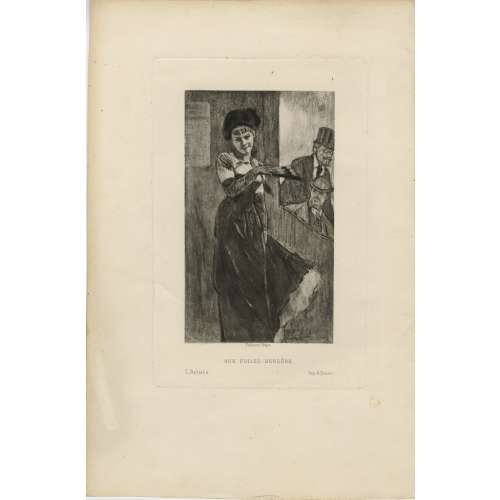
Aquatint finished by a drypoint on wove paper; printed by R. Taneur, depicting young woman in bar Folies Bergère in Paris. Signed in plate under image: "Félicien Rops | AUX FOLIES-BERGÈRE | L'Artiste. — Imp. R. Taneur. Owner's stamp 'LvM' on verso.
Dimensions: Paper: 26.7 x 17.6 cm; Plate: 17.5 x 11.5 cm; Image: 13.5 x 8 cm.
Catalogue raisonné: Graphics irreverent and erotic (1968): 125.
-
 The Bay of Kuroto in Kazusa province [Kazusa Kuroto no ura] – an uncut fan print showing "Three women, wearing stylish cotton summer robes are shown in a skiff, admiring the view of Mount Fuji while looking back at the other passengers being helped into small boats". From the series: Views of famous places in the provinces [Shokoku meisho zue]. Ref: Sebastian Izzard. Important Japanese Prints 1830–1860 March 14–20, 2020 exhibition [LIB-2398.2020], №. 53. Not in Faulkner's Hiroshige Fan Prints, however, there are three other prints from the series, under № 95, 96 and 97 on p. 95. Artist: Utagawa Hiroshige [歌川 広重] a.k.a. Andō Hiroshige [安藤 広重] (Japanese, 1797 – 1858). Publisher: Iseya Sōemon [伊勢屋惣右衛門] (Japanese, c. 1776 – 1862). Date seal: 2/1855 Signed: Hiroshige ga. Censor's seal: aratame (certified) and date. Publisher's seal: Iseya Sōemon. Size: Aiban yoko-e uchiwa-e; 22.9 x 29.8 cm
The Bay of Kuroto in Kazusa province [Kazusa Kuroto no ura] – an uncut fan print showing "Three women, wearing stylish cotton summer robes are shown in a skiff, admiring the view of Mount Fuji while looking back at the other passengers being helped into small boats". From the series: Views of famous places in the provinces [Shokoku meisho zue]. Ref: Sebastian Izzard. Important Japanese Prints 1830–1860 March 14–20, 2020 exhibition [LIB-2398.2020], №. 53. Not in Faulkner's Hiroshige Fan Prints, however, there are three other prints from the series, under № 95, 96 and 97 on p. 95. Artist: Utagawa Hiroshige [歌川 広重] a.k.a. Andō Hiroshige [安藤 広重] (Japanese, 1797 – 1858). Publisher: Iseya Sōemon [伊勢屋惣右衛門] (Japanese, c. 1776 – 1862). Date seal: 2/1855 Signed: Hiroshige ga. Censor's seal: aratame (certified) and date. Publisher's seal: Iseya Sōemon. Size: Aiban yoko-e uchiwa-e; 22.9 x 29.8 cm -
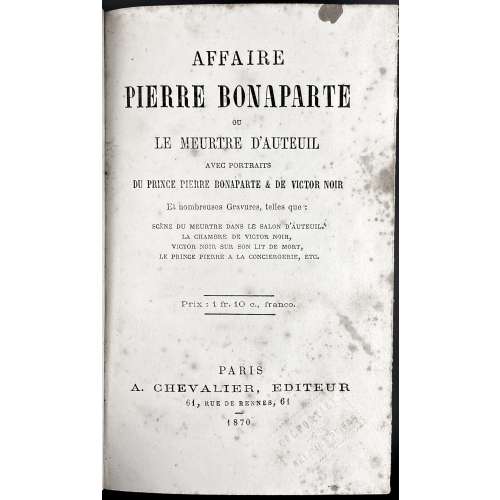 Description: 12mo, 17 x 11 cm, quarter brown morocco over marbled boards, marbled end-papers, raised bands and gilt lettering to spine, embossed stamp to t.p. “COLPORTAGE CHEMIN DE FER”. Title-page: AFFAIRE | PIERRE BONAPARTE | OU | LE MEURTRE D'AUTEUIL | AVEC PORTRAITS | DU PRINCE PIERRE BONAPARTE & DE VICTOR NOIR | Et nombreuses Gravures, telles que : | SCÈNE DU MEURTRE DANS LE SALON D'AUTEUIL. | LA CHAMBRE DE VICTOR NOIR, | VICTOR NOIR SUR SON LIT DE MORT, | LE PRINCE PIERRE A LA CONCIERGERIE, ETC. | — | Prix : 1 fr. 10 c., franco. | — | PARIS | A. CHEVALIER, EDITEUR | 61, RUE DE RENNES, 61 | 1870. Collation: 18mo; odd [1]-918; 5 x 18 = 90 leaves total. Pagination: [2] [3] 4-177 [178]; total 180 pages. Contributors: Armand Le Chevalier (French, 1802 – 1873) – publisher. Prince Pierre-Napoléon Bonaparte (French, 1815 – 1881) – character. Victor Noir [b. Yvan Salmon] (French-Jewish, 1848 – 1870) – character.
Description: 12mo, 17 x 11 cm, quarter brown morocco over marbled boards, marbled end-papers, raised bands and gilt lettering to spine, embossed stamp to t.p. “COLPORTAGE CHEMIN DE FER”. Title-page: AFFAIRE | PIERRE BONAPARTE | OU | LE MEURTRE D'AUTEUIL | AVEC PORTRAITS | DU PRINCE PIERRE BONAPARTE & DE VICTOR NOIR | Et nombreuses Gravures, telles que : | SCÈNE DU MEURTRE DANS LE SALON D'AUTEUIL. | LA CHAMBRE DE VICTOR NOIR, | VICTOR NOIR SUR SON LIT DE MORT, | LE PRINCE PIERRE A LA CONCIERGERIE, ETC. | — | Prix : 1 fr. 10 c., franco. | — | PARIS | A. CHEVALIER, EDITEUR | 61, RUE DE RENNES, 61 | 1870. Collation: 18mo; odd [1]-918; 5 x 18 = 90 leaves total. Pagination: [2] [3] 4-177 [178]; total 180 pages. Contributors: Armand Le Chevalier (French, 1802 – 1873) – publisher. Prince Pierre-Napoléon Bonaparte (French, 1815 – 1881) – character. Victor Noir [b. Yvan Salmon] (French-Jewish, 1848 – 1870) – character. -
 Title: Early Spring [初春之図] (Hatsuharu no zu); Series: Fashionable Twelve Months [今様十二ヶ月] (Imayo juni-kagetsu). Another version of translation: Modern Beauties of Twelve Months. Artist: Utagawa Toyokuni I [歌川豊国] (1769–1825). Pubisher: Ibaya Senzaburō [伊場屋仙三郎] (Japanese, 1815 – 1869), seal: Dansendō [伊場仙]. Signed: Toyokuni ga [豊国画] and sealed with toshidama. Date-kiwame seal: Ushi (ox), Bunsei 5 (1822). Size: double-sheet uncut fan print ( aiban uchiwa-e), each 217 x 288 mm. Ref: Tokyo Museum Collection.
Title: Early Spring [初春之図] (Hatsuharu no zu); Series: Fashionable Twelve Months [今様十二ヶ月] (Imayo juni-kagetsu). Another version of translation: Modern Beauties of Twelve Months. Artist: Utagawa Toyokuni I [歌川豊国] (1769–1825). Pubisher: Ibaya Senzaburō [伊場屋仙三郎] (Japanese, 1815 – 1869), seal: Dansendō [伊場仙]. Signed: Toyokuni ga [豊国画] and sealed with toshidama. Date-kiwame seal: Ushi (ox), Bunsei 5 (1822). Size: double-sheet uncut fan print ( aiban uchiwa-e), each 217 x 288 mm. Ref: Tokyo Museum Collection.
Other five prints of this series: SVJP 0326.2020; SVJP-0362.2022; SVJP-0363.2022; SVJP-0364.2022; SVJP-0365.2022.

-
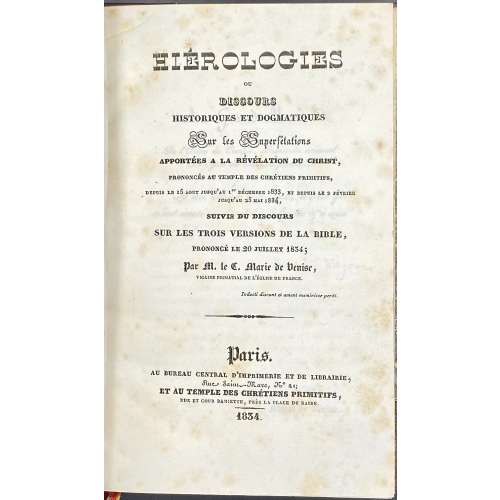 Hardcover volume, 20.7 x 13.5 cm, modern half morocco over marbled boards, gilt lettering and ornament to spine, pp.: [i-vii] viii-xvi [17] 18-255 [256], collated 8vo: 1-168, 128 leaves. Title-page: HIÉROLOGIES | OU | DISCOURS | HISTORIQUES ET DOGMATIQUES | Sur les Superfétations | APPORTÉES A LA RÉVÉLATION DU CHRIST, | PRONONCÉS AU TEMPLE DES CHRÉTIENS PRIMITIFS, | DEPUIS LE 15 AOUT JUSQU’AU 1er DÉCEMBRE 1833, ET DEPUIS LE 2 FÉVRIER | JUSQU’AU 25 MAI 1834, | SUIVIS DU DISCOURS | SUR LES TROIS VERSIONS DE LA BIBLE, | PRONONCÉ LE 20 JUILLET 1834 ; | Par M. le C. Marie de Venise, | VICAIRE PRIMATIAL DE L’EGLISE DE France. | {1 line citation} | — | Paris. | AU BUREAU CENTRAL D’IMPRIMERIE ET DE LIBRAIRE, | Rue Saint-Marc, No 21; | ET AU TEMPLE DES CHRÉTIENS PRIMITIFS, | RUE ET COUR DAMIETTE, PRÈS LA PLACE DU KAIRE. | — | 1834 || Contributors : Félix Ragon (French, 1795 – 1872) – author. Seller's description: [RAGON (Félix) : Hiérologies ou Discours historiques et dogmatiques sur les Superfétations apportées à la révélation du Christ suivis du Discours sur les trois versions de la Bible. Paris, au Bureau central et au Temple des Chrétiens Primitifs, 1834 ; in 8°, demi-basane brune à coins. Reliure pastiche moderne. Edition originale extrêmement rare, dont le tirage est estimé à 50 ex.
Hardcover volume, 20.7 x 13.5 cm, modern half morocco over marbled boards, gilt lettering and ornament to spine, pp.: [i-vii] viii-xvi [17] 18-255 [256], collated 8vo: 1-168, 128 leaves. Title-page: HIÉROLOGIES | OU | DISCOURS | HISTORIQUES ET DOGMATIQUES | Sur les Superfétations | APPORTÉES A LA RÉVÉLATION DU CHRIST, | PRONONCÉS AU TEMPLE DES CHRÉTIENS PRIMITIFS, | DEPUIS LE 15 AOUT JUSQU’AU 1er DÉCEMBRE 1833, ET DEPUIS LE 2 FÉVRIER | JUSQU’AU 25 MAI 1834, | SUIVIS DU DISCOURS | SUR LES TROIS VERSIONS DE LA BIBLE, | PRONONCÉ LE 20 JUILLET 1834 ; | Par M. le C. Marie de Venise, | VICAIRE PRIMATIAL DE L’EGLISE DE France. | {1 line citation} | — | Paris. | AU BUREAU CENTRAL D’IMPRIMERIE ET DE LIBRAIRE, | Rue Saint-Marc, No 21; | ET AU TEMPLE DES CHRÉTIENS PRIMITIFS, | RUE ET COUR DAMIETTE, PRÈS LA PLACE DU KAIRE. | — | 1834 || Contributors : Félix Ragon (French, 1795 – 1872) – author. Seller's description: [RAGON (Félix) : Hiérologies ou Discours historiques et dogmatiques sur les Superfétations apportées à la révélation du Christ suivis du Discours sur les trois versions de la Bible. Paris, au Bureau central et au Temple des Chrétiens Primitifs, 1834 ; in 8°, demi-basane brune à coins. Reliure pastiche moderne. Edition originale extrêmement rare, dont le tirage est estimé à 50 ex. -
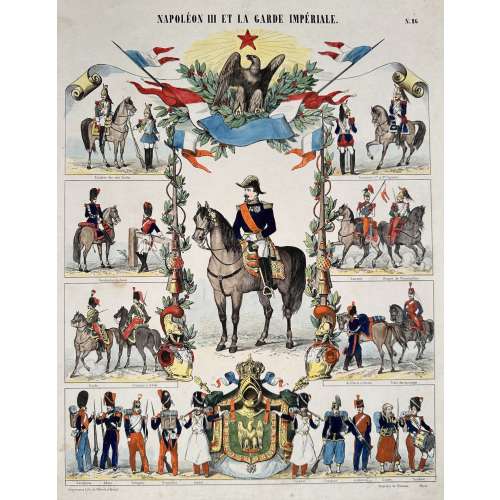 Hand-coloured woodcut on wove paper, 460 x 356 mm; black ink stamp “5055” to reverse. Top centre: "NAPOLÉON III ET LA GARDE IMPÉRIALE"; right: "№ 86". Napoléon III ahorseback in middle, beside (top to bottom): Escadron des cent Gardes — Cuirassiers 1er et 2me regiment; Gendarmes à cheval. — Lancier., Dragon de l’Impératrice.; Guide., Chasseur à cheval. — Artillerie à cheval, Train des équipages.; Gendarme. Génie. Voltigeur. Grenadier. Sapeur. Sapeur. Chasseur. Artillerie. Zouave. Tambour. Bottom left: Imprimerie Lith. de Pellerin à Épinal; right: Propriété de l’Éditeur. Déposé. Jean Charles Pellerin (French, 1756 – 1836) – printer/publisher.
Hand-coloured woodcut on wove paper, 460 x 356 mm; black ink stamp “5055” to reverse. Top centre: "NAPOLÉON III ET LA GARDE IMPÉRIALE"; right: "№ 86". Napoléon III ahorseback in middle, beside (top to bottom): Escadron des cent Gardes — Cuirassiers 1er et 2me regiment; Gendarmes à cheval. — Lancier., Dragon de l’Impératrice.; Guide., Chasseur à cheval. — Artillerie à cheval, Train des équipages.; Gendarme. Génie. Voltigeur. Grenadier. Sapeur. Sapeur. Chasseur. Artillerie. Zouave. Tambour. Bottom left: Imprimerie Lith. de Pellerin à Épinal; right: Propriété de l’Éditeur. Déposé. Jean Charles Pellerin (French, 1756 – 1836) – printer/publisher. -
 Artist: Utagawa Kunisada [歌川 国貞] a.k.a. Utagawa Toyokuni III [三代歌川豊国] (Japanese, 1786 – 1865). Signed: Toyokuni ga [豊国 画] in a red toshidama cartouche. Actor: Sawamura Gennosuke II [沢村源之助] (Japanese, 1802/7 – 1853); other names: Suketakaya Takasuke III, Sawamura Chōjūrō V [沢村長十郎], Sawamura Tosshō I, Sawamura Genpei I. Character: Kameya Chubei [亀屋忠兵衛] Play: Koi Bikyaku Yamato Orai [恋飛脚大和往来] Performance: Kawarasaki Theatre [河原崎座] in the 2nd month of 1851. Double nanushi censor seals: Fuku & Muramatsu, from 3rd month of Kaei 2 to 11th month of Kaei 4 (1849-51). Another fan print from the pair SVJP-0212-1.2016: Ichikawa Ebizō V as Tanbaya Onizo / Fan print, 1851.
Artist: Utagawa Kunisada [歌川 国貞] a.k.a. Utagawa Toyokuni III [三代歌川豊国] (Japanese, 1786 – 1865). Signed: Toyokuni ga [豊国 画] in a red toshidama cartouche. Actor: Sawamura Gennosuke II [沢村源之助] (Japanese, 1802/7 – 1853); other names: Suketakaya Takasuke III, Sawamura Chōjūrō V [沢村長十郎], Sawamura Tosshō I, Sawamura Genpei I. Character: Kameya Chubei [亀屋忠兵衛] Play: Koi Bikyaku Yamato Orai [恋飛脚大和往来] Performance: Kawarasaki Theatre [河原崎座] in the 2nd month of 1851. Double nanushi censor seals: Fuku & Muramatsu, from 3rd month of Kaei 2 to 11th month of Kaei 4 (1849-51). Another fan print from the pair SVJP-0212-1.2016: Ichikawa Ebizō V as Tanbaya Onizo / Fan print, 1851.
-
 Artist: Kitagawa Utamaro [喜多川 歌麿] (Japanese, c. 1753 – 1806) "This uncommon half-size horizontal ōban ... is most likely one design from a set of twelve prints issued late in Utamaro's life" [Japanese Erotic Fantasies, Hotei Publishing, 2005, p. 143, pl. 47]. Half-size horizontal ōban must be 12.7 x 38 cm. Richard Waldman and Chris Uhlenbeck say it's tanzaku size (13 x 43 cm). In reality, the prints of this series measure 17 x 38 cm, which corresponds exactly to horizontal o-hosoban paper size. I managed to assemble 11 of allegedly 12 designs. 7 of them have genitals colored by hand. It's hard to tell whether it was done by the publisher on demand of a peculiar buyer, or by the owner of the prints who considered the black and white privy parts unnatural. My sequencing of the prints is arbitrary. Transcription of the text may help find the correct order.
Artist: Kitagawa Utamaro [喜多川 歌麿] (Japanese, c. 1753 – 1806) "This uncommon half-size horizontal ōban ... is most likely one design from a set of twelve prints issued late in Utamaro's life" [Japanese Erotic Fantasies, Hotei Publishing, 2005, p. 143, pl. 47]. Half-size horizontal ōban must be 12.7 x 38 cm. Richard Waldman and Chris Uhlenbeck say it's tanzaku size (13 x 43 cm). In reality, the prints of this series measure 17 x 38 cm, which corresponds exactly to horizontal o-hosoban paper size. I managed to assemble 11 of allegedly 12 designs. 7 of them have genitals colored by hand. It's hard to tell whether it was done by the publisher on demand of a peculiar buyer, or by the owner of the prints who considered the black and white privy parts unnatural. My sequencing of the prints is arbitrary. Transcription of the text may help find the correct order. As Japanese Erotic Fantasies put it: "a couple engaged in love-making, their stare fixed outside the picture plane". This is the only image of series that has a reference in available western literature, and the only one found in museum collections: Rijksmuseum Amsterdam (RP-P-1999-2001-16); reference: Fukuda (ed.) (1990), pls. 11-2.
As Japanese Erotic Fantasies put it: "a couple engaged in love-making, their stare fixed outside the picture plane". This is the only image of series that has a reference in available western literature, and the only one found in museum collections: Rijksmuseum Amsterdam (RP-P-1999-2001-16); reference: Fukuda (ed.) (1990), pls. 11-2.
 The scene of this print looks quite similar to that of the Kiyonaga's Sode no maki:
The scene of this print looks quite similar to that of the Kiyonaga's Sode no maki:
 The woman is "a young lady-in-waiting of Shogun's Court or Daimyō's Mansion, enjoying a rare outing from her tedious chores" [Richard Lane]. She is fully dressed in her outer cloak (shikake), white paper hat (agebōshi or tsunokakushi), and toed socks (tabi). A book or maybe, onkotogami (roll of tissues known as 'paper for honourable act' ) is still in the folds of her kimono. She is holding an open fan, either to cover her and her lover's faces from an unsolicited witness or to bring some fresh air to their joined lips. The pair just started their sexual intercourse.
The woman is "a young lady-in-waiting of Shogun's Court or Daimyō's Mansion, enjoying a rare outing from her tedious chores" [Richard Lane]. She is fully dressed in her outer cloak (shikake), white paper hat (agebōshi or tsunokakushi), and toed socks (tabi). A book or maybe, onkotogami (roll of tissues known as 'paper for honourable act' ) is still in the folds of her kimono. She is holding an open fan, either to cover her and her lover's faces from an unsolicited witness or to bring some fresh air to their joined lips. The pair just started their sexual intercourse.
 A scene from medieval times. A courtier in eboshi cap having sex with an aristocratic young woman with a long straight hairstyle (suihatsu).
A scene from medieval times. A courtier in eboshi cap having sex with an aristocratic young woman with a long straight hairstyle (suihatsu).
 Completely naked couple in the moment of ejaculation. Lavish garments with paulownia leaves on a yellow background counterbalance the white bodies on red bedding. The form of a woman's cheeks is telling, but I don't know about what. Maybe her advanced age?
Completely naked couple in the moment of ejaculation. Lavish garments with paulownia leaves on a yellow background counterbalance the white bodies on red bedding. The form of a woman's cheeks is telling, but I don't know about what. Maybe her advanced age?
 The pose of the couple and the overall composition are similar to that of the previous sheet. Though the lovers are dressed, and the woman's hairdo is well kept. The male looks older and the woman - younger.
The pose of the couple and the overall composition are similar to that of the previous sheet. Though the lovers are dressed, and the woman's hairdo is well kept. The male looks older and the woman - younger.
 A man takes a young maid from behind. She clenches the sleeve of her kimono in her teeth; it's either the moment of penetration (beginning of intercourse) or of her orgasm (the end of it).
A man takes a young maid from behind. She clenches the sleeve of her kimono in her teeth; it's either the moment of penetration (beginning of intercourse) or of her orgasm (the end of it).
 This seems to be a forced intercourse between a lackey with extensive bodily hair and a young maid from the same household.
This seems to be a forced intercourse between a lackey with extensive bodily hair and a young maid from the same household.
 This design is very much like the other one presented below, which is described at Japanese Erotic Fantasies on page 136 (pl. 43b) as follows: "The viewer peers through a mosquito net to see a child fast asleep, while his mother or wet-nurse moves towards her partner. On our print there is no child; instead of a sleeping baby, there is a roll of onkotogami. Fewer objects make the overall image concise, almost laconic in comparison with the Ehon hana fubuki (1802) design:
This design is very much like the other one presented below, which is described at Japanese Erotic Fantasies on page 136 (pl. 43b) as follows: "The viewer peers through a mosquito net to see a child fast asleep, while his mother or wet-nurse moves towards her partner. On our print there is no child; instead of a sleeping baby, there is a roll of onkotogami. Fewer objects make the overall image concise, almost laconic in comparison with the Ehon hana fubuki (1802) design:

 A young couple in a moment of true love. He is listening to the beating of her heart.
A young couple in a moment of true love. He is listening to the beating of her heart.
 This is a moment of true love between an old monk and a young samurai. The latter even did not take of his socks (tabi).
This is a moment of true love between an old monk and a young samurai. The latter even did not take of his socks (tabi).
 From Japanese Erotic Fantasies: "Boats played a crucial role in the workings of Yoshiwara, as they were the primary means of transport to the district. During the hot summer months, trips on pleasure boats were also a favourite pastime. Sex aboard a boat is a recurrent theme in shunga".
The last print that I am currently lacking and hunting for:
From Japanese Erotic Fantasies: "Boats played a crucial role in the workings of Yoshiwara, as they were the primary means of transport to the district. During the hot summer months, trips on pleasure boats were also a favourite pastime. Sex aboard a boat is a recurrent theme in shunga".
The last print that I am currently lacking and hunting for:
 I know where it is, but I cannot reach it... yet.
I know where it is, but I cannot reach it... yet.





